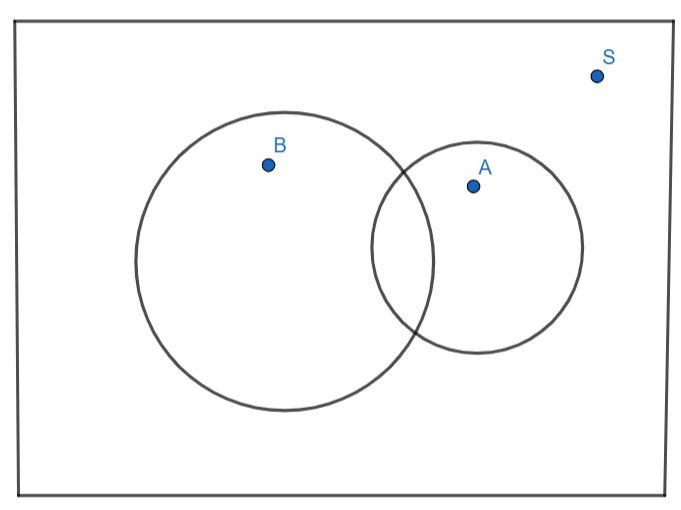
If A and B are two events such that \[P(A) = \dfrac{1}{4}\] , \[P(B) = \dfrac{1}{3}\] and \[P(A \cup B) = \dfrac{1}{2}\], then show that A and B are independent events.
Answer
606.3k+ views
Hint: For independent events, \[P(A \cap B) = P(A).P(B)\] . Hence, we find \[P(A \cap B)\] and then we find \[P(A).P(B)\] and show that they both are equal.
Complete step-by-step answer:
Independent events are events such that probability of occurrence of one of them does not affect the occurrence of the other.
Independent events A and B satisfy the relation as follows:
\[P(A \cap B) = P(A).P(B){\text{ }}..........{\text{(1)}}\]

From the figure, we can observe that the sum of probability of occurrence of the event A and probability of occurrence of event B is equal to the sum of probability of occurrence of both event A and B and probability of occurrence of event A or event B.
\[P(A) + P(B) = P(A \cap B) + P(A \cup B){\text{ }}..........{\text{(2)}}\]
The probabilities of A, B and \[A \cup B\] are given as follows:
\[P(A) = \dfrac{1}{4}\]
\[P(B) = \dfrac{1}{3}\]
\[P(A \cup B) = \dfrac{1}{2}\]
Substituting these in equation (2), we get:
\[\dfrac{1}{4} + \dfrac{1}{3} = P(A \cap B) + \dfrac{1}{2}{\text{ }}\]
Simplifying the left-hand side, we get:
\[\dfrac{{3 + 4}}{{12}} = P(A \cap B) + \dfrac{1}{2}\]
\[\dfrac{7}{{12}} = P(A \cap B) + \dfrac{1}{2}\]
Now, solving for \[P(A \cap B)\] , we get:
\[P(A \cap B) = \dfrac{7}{{12}} - \dfrac{1}{2}\]
Simplifying the right-hand side of the equation, we get:
\[P(A \cap B) = \dfrac{{7 - 6}}{{12}}\]
\[P(A \cap B) = \dfrac{1}{{12}}{\text{ }}..........{\text{(3)}}\]
Hence, we obtained the value of \[P(A \cap B)\] .
Next, we compute the value of the product of probability of A and B.
We have:
\[P(A).P(B) = \dfrac{1}{4}.\dfrac{1}{3}\]
Multiplying the right-hand side of the equation, we have:
\[P(A).P(B) = \dfrac{1}{{12}}{\text{ }}...........{\text{(4)}}\]
From, equation (3) and equation (4), we observe that both the RHS are equal, hence LHS also are equal, we have:
\[P(A).P(B) = P(A \cap B)\]
This is nothing but equation (1), satisfying the condition for independent events.
Hence, we showed that A and B are independent events.
Note: A common mistake you can make is taking \[P(A) + P(B) = 1 = P(A \cup B) + P(A \cap B)\] and proceeding to solve for \[P(A \cap B)\] , which is wrong. You can observe that \[P(A) + P(B) = \dfrac{1}{4} + \dfrac{1}{3} = \dfrac{7}{{12}} \ne 1\] . However, \[P(A) + P(B) = P(A \cup B) + P(A \cap B)\] , always holds true.
Complete step-by-step answer:
Independent events are events such that probability of occurrence of one of them does not affect the occurrence of the other.
Independent events A and B satisfy the relation as follows:
\[P(A \cap B) = P(A).P(B){\text{ }}..........{\text{(1)}}\]

From the figure, we can observe that the sum of probability of occurrence of the event A and probability of occurrence of event B is equal to the sum of probability of occurrence of both event A and B and probability of occurrence of event A or event B.
\[P(A) + P(B) = P(A \cap B) + P(A \cup B){\text{ }}..........{\text{(2)}}\]
The probabilities of A, B and \[A \cup B\] are given as follows:
\[P(A) = \dfrac{1}{4}\]
\[P(B) = \dfrac{1}{3}\]
\[P(A \cup B) = \dfrac{1}{2}\]
Substituting these in equation (2), we get:
\[\dfrac{1}{4} + \dfrac{1}{3} = P(A \cap B) + \dfrac{1}{2}{\text{ }}\]
Simplifying the left-hand side, we get:
\[\dfrac{{3 + 4}}{{12}} = P(A \cap B) + \dfrac{1}{2}\]
\[\dfrac{7}{{12}} = P(A \cap B) + \dfrac{1}{2}\]
Now, solving for \[P(A \cap B)\] , we get:
\[P(A \cap B) = \dfrac{7}{{12}} - \dfrac{1}{2}\]
Simplifying the right-hand side of the equation, we get:
\[P(A \cap B) = \dfrac{{7 - 6}}{{12}}\]
\[P(A \cap B) = \dfrac{1}{{12}}{\text{ }}..........{\text{(3)}}\]
Hence, we obtained the value of \[P(A \cap B)\] .
Next, we compute the value of the product of probability of A and B.
We have:
\[P(A).P(B) = \dfrac{1}{4}.\dfrac{1}{3}\]
Multiplying the right-hand side of the equation, we have:
\[P(A).P(B) = \dfrac{1}{{12}}{\text{ }}...........{\text{(4)}}\]
From, equation (3) and equation (4), we observe that both the RHS are equal, hence LHS also are equal, we have:
\[P(A).P(B) = P(A \cap B)\]
This is nothing but equation (1), satisfying the condition for independent events.
Hence, we showed that A and B are independent events.
Note: A common mistake you can make is taking \[P(A) + P(B) = 1 = P(A \cup B) + P(A \cap B)\] and proceeding to solve for \[P(A \cap B)\] , which is wrong. You can observe that \[P(A) + P(B) = \dfrac{1}{4} + \dfrac{1}{3} = \dfrac{7}{{12}} \ne 1\] . However, \[P(A) + P(B) = P(A \cup B) + P(A \cap B)\] , always holds true.
Recently Updated Pages
Why are manures considered better than fertilizers class 11 biology CBSE

Find the coordinates of the midpoint of the line segment class 11 maths CBSE

Distinguish between static friction limiting friction class 11 physics CBSE

The Chairman of the constituent Assembly was A Jawaharlal class 11 social science CBSE

The first National Commission on Labour NCL submitted class 11 social science CBSE

Number of all subshell of n + l 7 is A 4 B 5 C 6 D class 11 chemistry CBSE

Trending doubts
What is meant by exothermic and endothermic reactions class 11 chemistry CBSE

10 examples of friction in our daily life

One Metric ton is equal to kg A 10000 B 1000 C 100 class 11 physics CBSE

1 Quintal is equal to a 110 kg b 10 kg c 100kg d 1000 class 11 physics CBSE

Difference Between Prokaryotic Cells and Eukaryotic Cells

What are Quantum numbers Explain the quantum number class 11 chemistry CBSE




